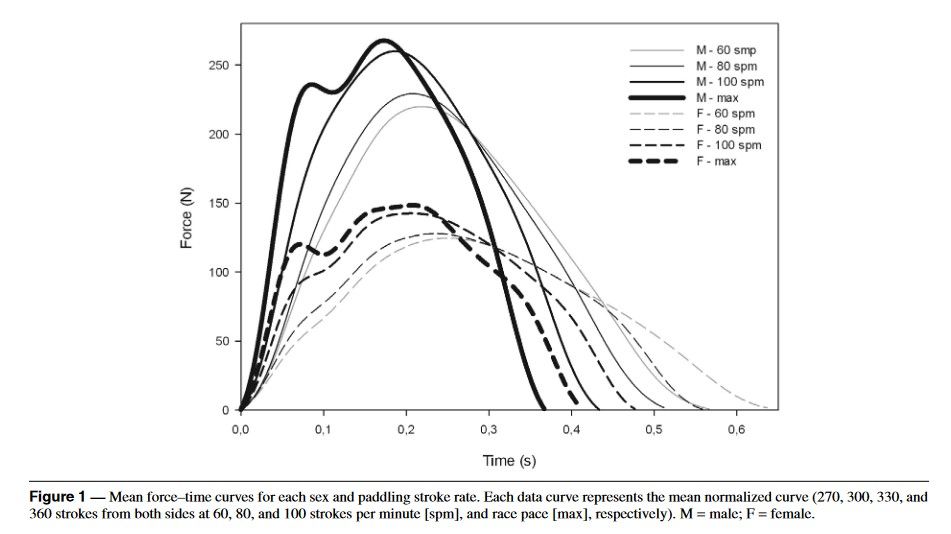Dragon boating, with its fusion of strength, coordination, and teamwork, is more than just a thrilling water sport; it’s a precise science of strokes and forces. In this blog post, we’ll dive into the intricacies of paddling technique, exploring the connection between a force curve and performance in dragon boat racing.
Understanding the Basics
Let’s break down the technical jargon and get to the heart of the matter.
A crucial aspect of efficient paddling involves optimizing the force curve, a fancy way of saying how much power you apply to the water throughout your stroke. Most dragon boaters have a stroke profile or force curve that looks like those in Figure 1


A Typical Force Curve
Researchers found that as the stroke rate (SR) and mean velocity increase, the force curve tends to shift towards a rectangular shape. See Figure 1.
Notice how the male’s force curve was more like the typical force curve at the lower stroke rates but starts evolving into a more rectangular shape at max rate. Also note how the female’s force curve is more rectangular, less peaky, than the males, even at high stroke rates.

The Rectangular Force Profile Advantage
Why does this matter? Picture your paddle stroke as a graph; a rectangular force profile is like hitting the sweet spot. It maximizes the area under the force–time curve, giving you more bang for your buck in terms of achievable peak force (Fpeak) while minimizing the time you spend applying that force.

Note: In Figure 2, we have stretched out the high stroke rate and Ideal force curves to align with a standard force curve (grey dotted line). Basically, indicating that the high stroke rate shape is being executed at a low stroke rate.
This allows us to visually compare the shapes and to be able to compare the impulse efficiency (area under the curve) and the ratio of average force to peak force, in the accompanying Table 1.
| Paddler | Relative Area Under the Force Curve (Higher = Better) | Fmean/Fpeak (Higher = Better) |
| Ideal (Rectangular) | 17 | 0.70 |
| Male (High SR) | 13 | 0.63 |
| Female (High SR) | 14 | 0.66 |
| Typical Paddler (Low SR) | 10 | 0.47 |
Table 1 Area under the force curves and Fmean/Fpeak for the graph above
Decoding the Delay Game in Your Force Curve
Now, let’s talk about timing. The delay between force application and dragon boat acceleration decreases as the Fmean/Fpeak ratio rises with increasing SR.
Translation? Keep your average force (Fmean) through your stroke as high as possible.
How? You want a swift start to your stroke, creating a near vertical force curve slope at the beginning of the water phase. This not only indicates stroke efficiency but also contributes to a rapid achievement of Fpeak – a key indicator of a powerful stroke.
Youi also want to NOT ease off on the force at the back end of your stroke. Easing off will cause the force curve to trail off – instead keep the force on to give it a fast decrease at the back end of the curve.

Navigating the Water Phase
As you approach the end of the water phase, things get interesting. A decreasing delay between dragon boat deceleration and the end of force application suggests that at low SR, keeping the blade in the water might actually slow you down. The force generated in this phase may not be sufficient to overcome the drag produced by the blade, emphasizing the importance of timing and technique.
So do we exit early which lifts the rate and cuts the “tail” of the force curve making it look more like a rectangle?
Or do we train to maintain maximum force throughout the stroke and exit clean?
…. The remainder of this content is for members only…
Reference:
Paddling Force Profiles at Different Stroke Rates in Elite Sprint Kayaking













